On This Page:
Attachment theory is a lifespan model of human development emphasizing the central role of caregivers (attachment figures) who provide a sense of safety and security.
Attachment theory hypothesizes that early caregiver relationships establish social–emotional developmental foundations, but change remains possible across the lifespan due to interpersonal relationships during childhood, adolescence, and adulthood.
Attachment can be defined as a deep and enduring emotional bond between two people in which each seeks closeness and feels more secure when in the presence of the attachment figure.
The initial and perhaps most crucial emotional bond forms between infants and their primary caregivers.
Distinct behaviors characterize attachment in children and adults, such as seeking closeness with the attachment figure when distressed or threatened (Bowlby, 1969).
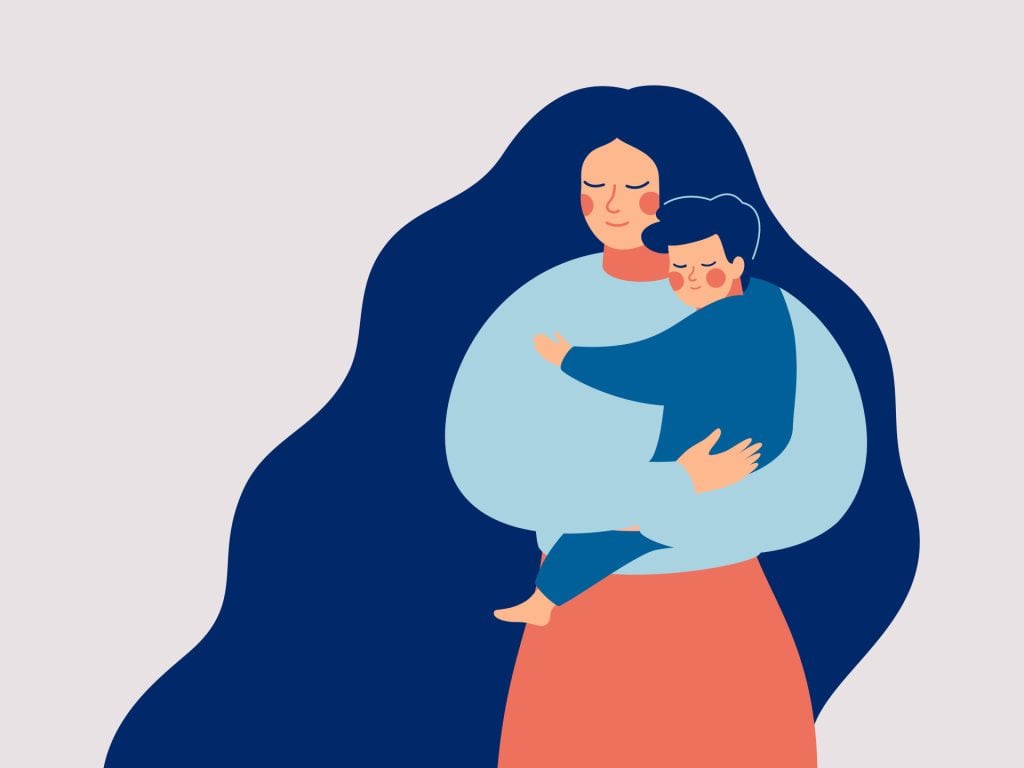
John Bowlby
Attachment theory in psychology finds its roots in the pioneering work of John Bowlby (1958). During the 1930s, Bowlby was a psychiatrist at a Child Guidance Clinic in London, treating numerous emotionally troubled children.
His experiences there underscored the significance of a child’s relationship with their mother in shaping their social, emotional, and cognitive development.
It molded his understanding of the connection between early separations from the mother and subsequent maladjustment, leading him to develop his attachment theory.
The attachment bond isn’t coincidental. Its primary purpose is to ensure the survival of the vulnerable infant, requiring the constant presence of a caregiver (Bowlby, 1973, 1980).
Viewed from this lens, attachment emerges as an evolutionary concept. The behavior of seeking proximity is universally observed across cultures (Van Ijzendoorn & Sagi-Schwartz, 2008).
Bowlby (1988) contended that the drive for proximity arises from an interconnected set of behavioral systems that collectively shape behavior. These include the attachment, caregiving, and exploratory behavioral systems.
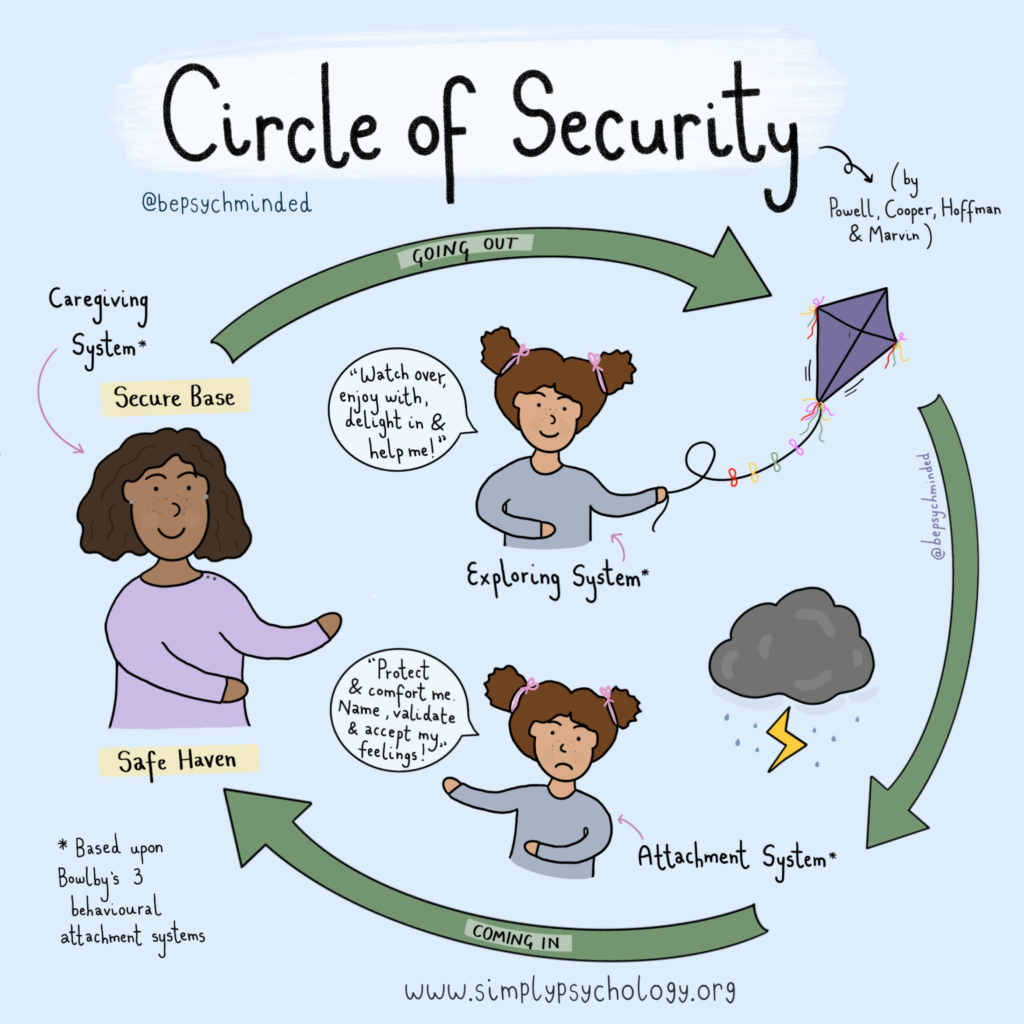
Attachment Behavioral System
The attachment behavioral system concerns the tendency of an individual to seek security during times of stress (Mikulincer & Shaver, 2003), which can be internal (i.e., hunger, fatigue, illness) or from external features of the environment, such as threatening stimuli (Bowlby, 1988).
The more extreme the stress, the more intense the attachment system activation. The attachment system is most readily activated during the first five years of life, a period characterized by high levels of vulnerability and dependence.
Once the attachment system is activated, the infant is motivated to seek proximity to significant others (attachment figures) to protect themselves from physical or emotional harm (Bowlby, 1969).
If this goal is achieved, the infant develops feelings of safety and security, and their attachment system becomes deactivated. The infant will call upon a range of attachment behaviors with the goal of attaining proximity to the attachment figure.
Bowlby (1988) suggests the attachment behavioral system remains important throughout life and will also motivate adults to seek proximity in times of stress during adulthood.
Caregiving System
The attachment figure is viewed as a ‘safe haven’, and their role is to correspondingly alter their level of responsiveness to deactivate the infant’s attachment system by promoting feelings of security.
George and Solomon (1996) call this reciprocal response of the attachment figure to the infant’s attachment system the ‘caregiving’ system.
Bowlby (1969) posits that the caregiving system exists to provide protection and support to others in need of assistance, through providing sensitive and responsive care.
The caregiving system is activated when an individual expresses a need for support or their attachment system is activated, and is deactivated when the care recipient appears to be in a secure state (Shaver & Mikulincer, 2006).
Once activated, the caregiver may utilize a variety of behavioral strategies intended to improve the other person’s well-being, re-establishing their felt security, and facilitating their coping efforts.
Caregiving strategies include validating a person’s worries, providing physical closeness and affection, and communicating that a person is loved and valued (Mikulincer & Shaver, 2007).
In addition to attachment behaviors, the caregiving system can support exploratory behaviors (Feeney, 2004).
The Importance of Early Emotional Bonds
- Attachment behavior in adults toward the child includes responding sensitively and appropriately to the child’s needs. Such behavior appears universal across cultures.
- Attachments are most likely to form with those who responded accurately to the baby’s signals, not the person they spent more time with. Schaffer and Emerson called this sensitive responsiveness.
- Reciprocity is the mutual, two-way interaction between an infant and caregiver, where both respond to each other’s signals, such as when a baby’s smile evokes a smile in return. This form of interactional synchrony is vital for a child’s development, establishing their foundational trust and shaping future relationships and learning.
Exploratory Behavioral System
When infants feel safe and secure, and their attachment system is deactivated, their energy can be devoted to what Bowlby (1969) refers to as the exploratory behavioral system.
The exploratory behavioral system refers to behaviors that drive the organism to interact with the environment in a bid to inspect it, manipulate it, and master it (Mikulincer & Shaver, 2007).
According to Bowlby (1969), the exploratory system is activated by novelty and is terminated when a person exhibits a sense of competence and familiarity with their environment. From this perspective, attachment figures can also be seen as a ‘secure base’ which infants use to explore their social world (Ainsworth, Blehar, Waters, & Wall, 1978).
The more assured the infant is in the availability of their attachment figure in times of stress, the more likely they will interact with others and their environment. Thus attachment, far from interfering with exploration, is viewed as nurturing exploration.
Caregivers who provide a secure base allow infants to become autonomous, inquisitive, and experimental. Children who lack a secure base find their attachment system keeps overriding their attempts to be autonomous and to competently interact with their social environment.
This, in turn, can impair and harm a child’s social, emotional, and cognitive development (Bowlby, 1980). Of course, not all attachment figures become a secure base, and this function is based on the responsiveness of their caregiver towards the infant (Ainsworth & Wittig, 1969).
Ainsworth et al. proposed the interconnecting between attachment and exploratory systems are adaptive as they ensure a balance between protection and exploration of the social and physical environment.
Ainsworth’s Strange Situation
Mary Ainsworth and her colleagues discovered three major patterns that infants attach to their primary caregivers (“mother figures”) from their Strange Situation Procedure (Ainsworth et al., 1978).
The study recruited four different samples of infants at around one year of age, and engaged them in the Strange Situation procedure, roughly described below:
An infant was put into an unfamiliar environment with his or her mother and was free to explore the environment; a stranger entered the room and gradually approached the infant; the mother then left the room, returning after the infant spent some time alone with the stranger.
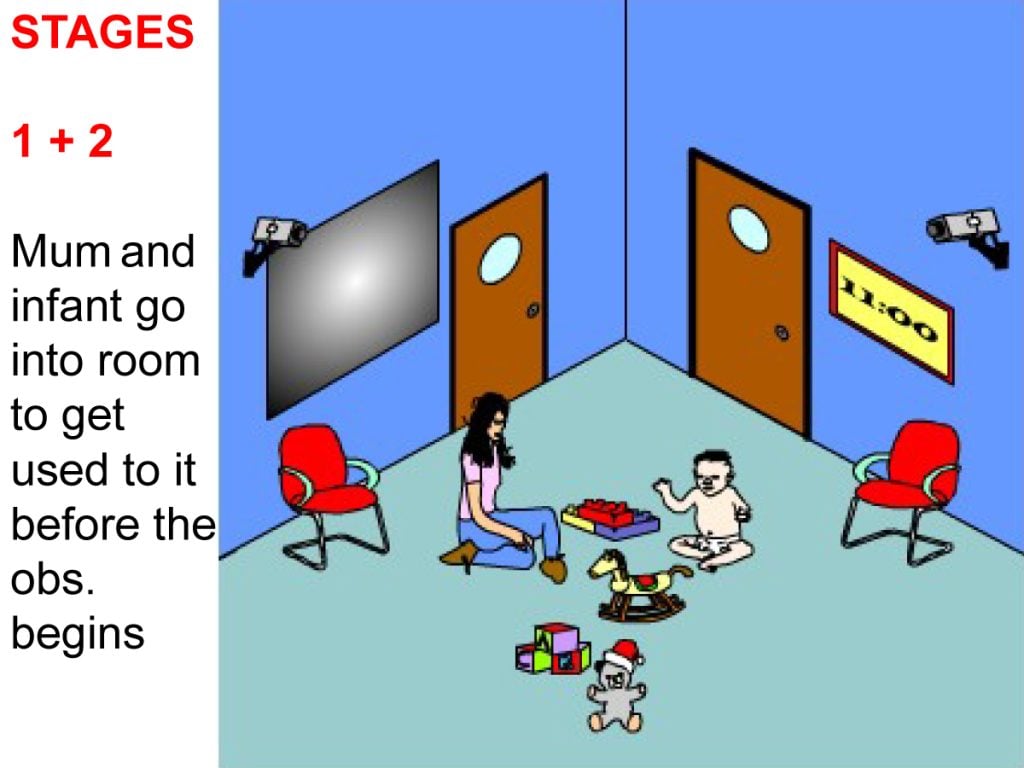
Ainsworth and colleagues observed how comfortable each infant was physically farther away from the mother in an unfamiliar environment, how each infant interacted with the stranger, and how each infant greeted the mother upon her return.
Based on the observations, they sorted the infants into three groups: secure, anxious, and avoidant.
Attachment Styles
Attachment styles refer to the particular way in which an individual relates to other people. The style of attachment is formed at the very beginning of life, and once established, it is a style that stays with you and plays out today in how you relate in intimate relationships and in how you parent your children.
The concept involves one’s confidence in the availability of the attachment figure for use as a secure base from which one can freely explore the world when not in distress and a safe haven from which one can seek support, protection, and comfort in times of distress.
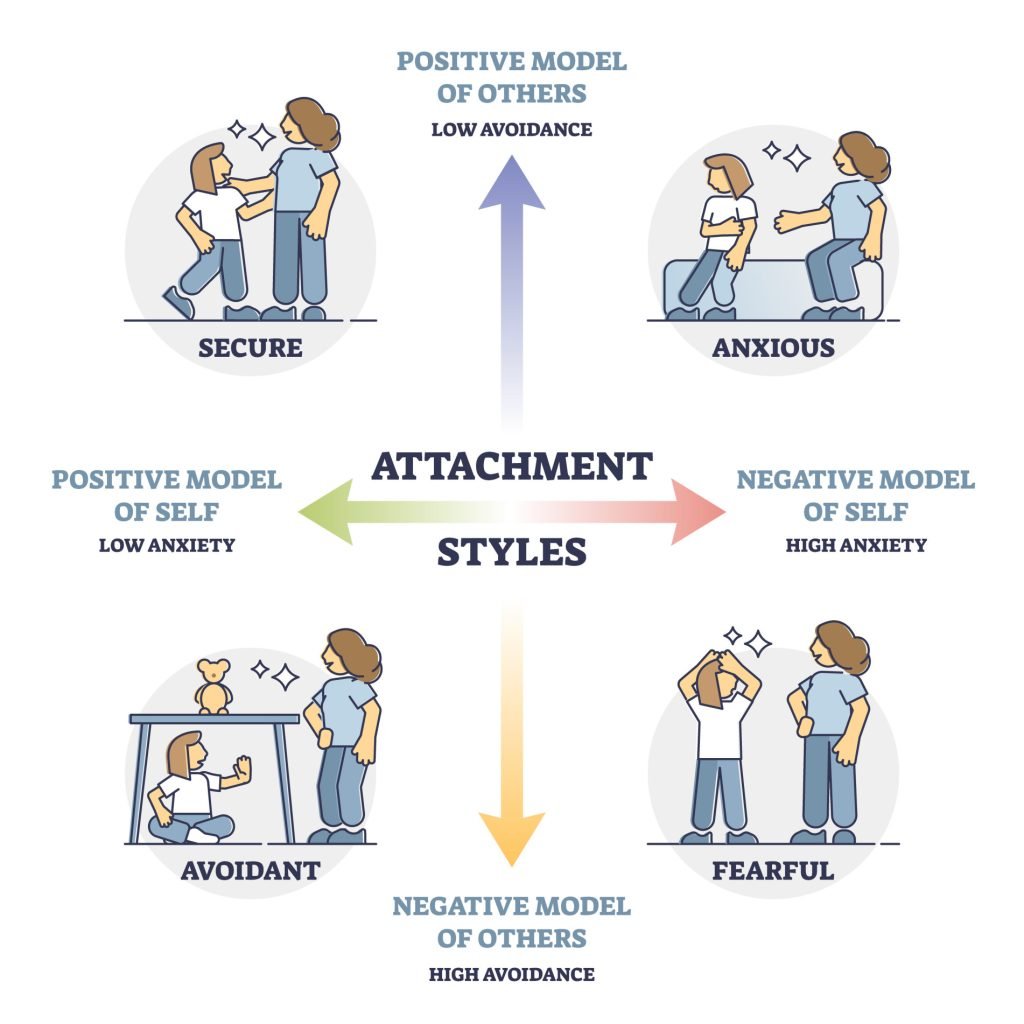
Secure Attachment
Bowlby (1988) described secure attachment as the capacity to connect well and securely in relationships with others while also having the capacity for autonomous action as situationally appropriate.
Secure attachment is characterized by trust, an adaptive response to being abandoned, and the belief that one is worthy of love.
An infant with a secure attachment is characterized as actively seeking and maintaining proximity with the mother, especially during the reunion episode. The infant may or may not be friendly with the stranger, but always shows more interest in interacting with the mother.
Additionally, during the same situation the infant tended to be slightly distressed during separation from the mother, but the infant rarely cried.
Ainsworth and colleagues interpreted infants who were securely attached to their mothers, showed less anxiousness and more positive attitudes toward the relationship, and were likely because they believed in their mothers’ responsiveness towards their needs.
Anxious (Ambivalent) Attachment
Anxious attachment (also called ambivalent) relationships are characterized by a concern that others will not reciprocate one’s desire for intimacy. This is
caused when an infant learns that their caregiver or parent is unreliable and does not consistently provide responsive care towards their needs.
An anxiously attached infant is characterized as being somewhat ambivalent (and resistant) to the mother. The infant often demonstrated signs of resisting interactions with the mother, especially during the strange situation reunion episode.
However, once contact with the mother was gained, the infant also showed strong intentions to maintain such contact. Overall, ambivalent infants often displayed maladaptive behaviors throughout the Strange Situation.
Ainsworth and colleagues found ambivalent infants to be anxious and unconfident about their mothers’ responsiveness, and their mothers were observed to lack “the fine sense of timing” in responding to the infants’ needs.
As adults, those with an anxious preoccupied attachment style are overly concerned with the uncertainty of a relationship. They hold a negative working model of self and a positive working model of others.
Avoidant Attachment
Children with avoidant attachment styles tend to avoid interaction with the caregiver, and show no distress during separation. This may be because the parent has ignored attempts to be intimate, and the child may internalize the belief that they cannot depend on this or any other relationship.
An infant with an avoidant attachment was characterized as displaying little to no tendency to seek proximity with the mother.
The infant often showed no distress during separation from the mother, interacted with the stranger similarly to how he or she would interact with the mother, and showed slight signs of avoidance (turning away, avoiding eye contact, etc.) when reunited with the mother.
Ainsworth and colleagues interpreted infants’ avoidance behaviors as a defensive mechanism against the mothers’ own rejecting behaviors, such as being uncomfortable with physical contact or being more easily angered by the infants.
Disorganized (Fearful) Attachment
Main and Solomon (1986) discovered that a sizable proportion of infants did not fit into secure, anxious, or avoidant, based on their behaviors in the Strange Situation experiment. They categorized these infants as having a disorganized attachment type.
Disorganized attachment is classified by children who display sequences of behaviors that lack readily observable goals or intentions, including obviously contradictory behaviors or stilling/freezing of movements.
Main and Solomon found that the parents of disorganized infants often had unresolved attachment-related traumas, which caused the parents to display either frightened or frightening behaviors, resulting in the disorganized infants being confused or forcing them to rely on someone they were afraid of at the same time.
Stages of Attachment
Rudolph Schaffer and Peggy Emerson (1964) investigated if attachment develops through a series of stages by studying 60 babies at monthly intervals for the first 18 months of life (this is known as a longitudinal study).
The children were all studied in their own homes, and a regular pattern was identified in the development of attachment.
The babies were visited monthly for approximately one year, their interactions with their carers were observed, and carers were interviewed.
A diary was kept by the mother to examine the evidence for the development of attachment. Three measures were recorded:
• Stranger Anxiety – response to arrival of a stranger.
• Separation Anxiety – distress level when separated from carer, degree of comfort needed on return.
• Social Referencing – degree that child looks at carer to check how they should respond to something new (secure base).
They discovered that baby’s attachments develop in the following sequence:
Asocial (0 – 6 weeks)
Very young infants are asocial in that many kinds of stimuli, both social and non-social, produce a favorable reaction, such as a smile.
Indiscriminate Attachments (6 weeks to 7 months)
Infants indiscriminately enjoy human company; most babies respond equally to any caregiver. They get upset when an individual ceases to interact with them.
From 3 months, infants smile more at familiar faces and can be easily comfortable by a regular caregiver.
Specific Attachment (7 – 9 months)
Special preference for a single attachment figure. The baby looks to particular people for security, comfort, and protection. It shows fear of strangers (stranger fear) and unhappiness when separated from a special person (separation anxiety).
Some babies show stranger fear and separation anxiety much more frequently and intensely than others; nevertheless, they are seen as evidence that the baby has formed an attachment. This has usually developed by one year of age.
Multiple Attachment (10 months and onwards)
Many of the babies from the Schaffer and Emerson study had multiple attachments by 10 months old, including attachments to mothers, fathers, grandparents, siblings, and neighbors.
The baby becomes increasingly independent and forms several attachments. By 18 months, the majority of infants have formed multiple attachments.
The multiple attachments formed by most infants vary in their strength and importance to the infant. Attachments are often structured in a hierarchy, whereby an infant may have formed three attachments, but one may be stronger than the other two, and one may be the weakest.
The results of the study indicated that attachments were most likely to form with those who responded accurately to the baby’s signals, not the person they spent more time with. Schaffer and Emerson called this sensitive responsiveness.
Intensely attached infants had mothers who responded quickly to their demands and, interacted with their child. Infants who were weakly attached had mothers who failed to interact.
The Lasting Impact of Early Attachment
According to Bowlby’s theory (1988), when we form our primary attachment, we also make a mental representation of what a relationship is (internal working model), which we then use for all other relationships in the future i.e., friendships, working, and romantic relationships.
The different attachment styles may be viewed as internal working models of “relationships” that evolved from event experiences (Main, Kaplan, & Cassidy, 1985).
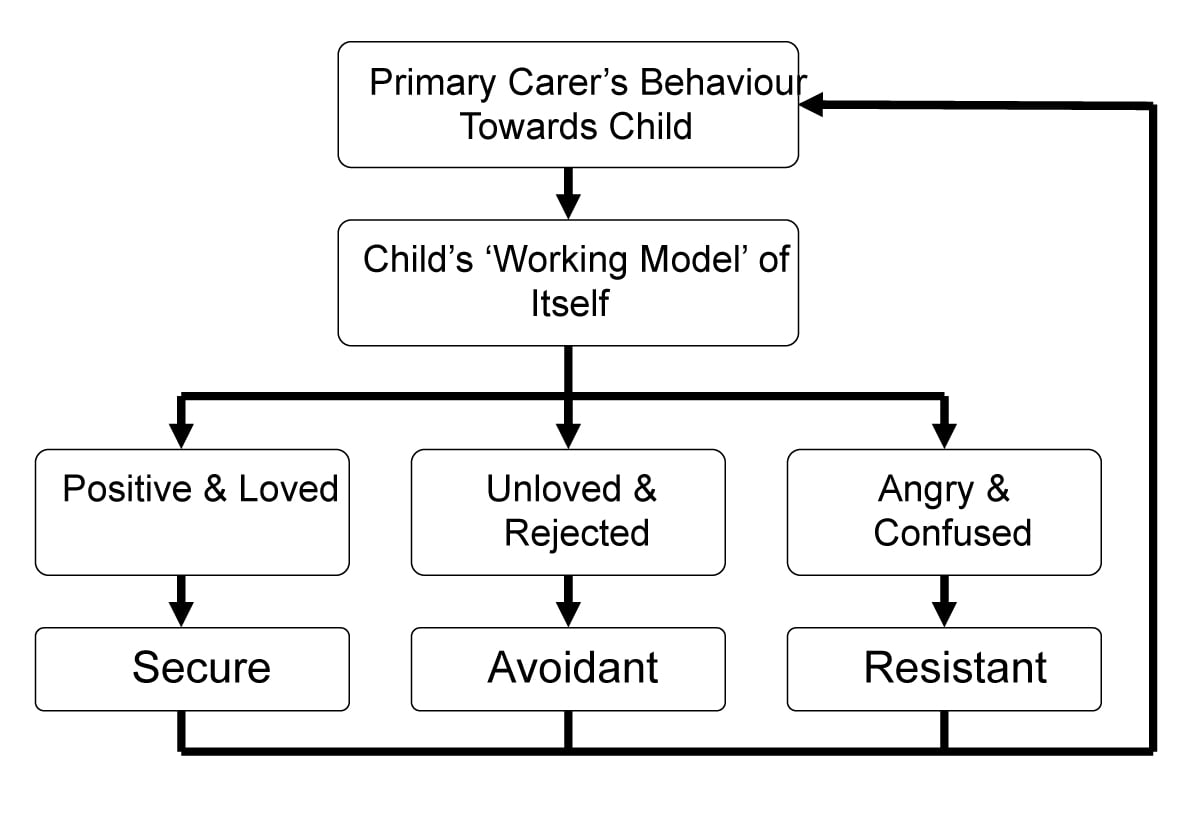
This would suggest that early interactions with caregivers could not only shape how an infant understood and behaved in relationships (as exemplified by infant attachment styles), but that such impact could be carried forward into adult attachment.
According to Bowlby (1969) later relationships are likely to be a continuation of early attachment styles (secure and insecure) because the behavior of the infant’s primary attachment figure promotes an internal working model of relationships which leads the infant to expect the same in later relationships.
In other words, there will be continuity between early attachment experiences and later relationships. This is known as the continuity hypothesis.
In humans, attachment does not conclude in infancy, or even childhood, but instead is active throughout the lifespan, with individuals gaining comfort from both physical and mental representations of significant others (Bowlby, 1969).
It is through an individual’s internal working model that childhood patterns of attachment are carried forward across the life cycle into adolescence and adulthood.
The notion of security is still an important one; however, the growing emergence of autonomy is also significant as the attachment system in adults is less likely to be activated due to them being able to tolerate higher levels of distress compared to children.
During adulthood, new attachment bonds are formed which may become a significant source of support during periods of distress, or during periods of goal achievement and exploration.
Researchers have proposed that working models are interconnected within a complex hierarchical structure (Bowlby, 1980; Bretherton, 1985, 1990; Collins & Read, 1994; Main, Kaplan, & Cassidy, 1985).

For example, the highest level model comprises beliefs and expectations across all types of relationship, and lower level models hold general rules about specific relations, such as romantic or parental, underpinned by models specific to events within a relationship with a single person.
The existence of multiple mental models is supported by evidence which demonstrates considerable within-person variability in the expectations and beliefs that people hold about the self and others (Baldwin & Fehr, 1995).
Furthermore, although specific models of attachment relationships are positively associated with more overarching general working models, the correlations are small to moderate (less than .40), indicating that they comprised distinct beliefs regarding the self and significant others (Cozzarelli, Hoekstra, & Bylsma, 2000).
Likely, general mental models indicate a typical appraisal of the self and others across relationships, and relationship-specific beliefs about the self and one’s partner would plausibly represent only a part of these generalized beliefs.
Key Takeaways
- Attachment is defined as a “lasting psychological connectedness between human beings” (Bowlby, 1969, p. 194), and may be considered interchangeable with concepts such as “affectional bond” and “emotional bond.”
- Attachment is characterized by specific behaviors in children, such as seeking proximity to the attachment figure when upset or threatened (Bowlby, 1969).
- Attachment theory explains how the parent-child relationship emerges and influences subsequent development.
- A person’s first attachment is often established with the primary caregiver during infancy. However, it must be noted that attachment is not unique to infant-caregiver relationships but may also be present in other social relationships.
- Attachments of various kinds are formed through the repeated act of “attachment behaviors” or “attachment transactions,” a continuing process of seeking and maintaining a certain level of proximity to another specified individual (Bowlby, 1969).
- Because caregivers vary in sensitivity and responsiveness, not all infants attach to caregivers in the same way.
References
Ainsworth, M. D. S., & Bell, S. M. (1970). Attachment, exploration, and separation: Illustrated by the behavior of one-year-olds in a strange situation. Child Development, 41, 49-67.
Ainsworth, M. D. S. (1973). The development of infant-mother attachment. In B. Cardwell & H. Ricciuti (Eds.), Review of child development research (Vol. 3, pp. 1-94) Chicago: University of Chicago Press.
Ainsworth, M. D. S., Blehar, M. C., Waters, E., & Wall, S. (1978). Patterns of attachment: A psychological study of the strange situation. Lawrence Erlbaum.
Ainsworth, M. D. S. (1991). Attachments and other affectional bonds across the life cycle. In C . M. Parkes, J. Stevenson-Hinde, & P. Marris (Eds.), Attachment across the life cycle (pp. 33-51). London: Routledge.
Ainsworth. M. D. S., & Wittig, B. A. (1969) Attachment and exploratory behaviour of one-year-olds in a strange situation. In: B. M. Foss (Ed.) Determinants of infant behaviour, IV. London: Methuen, p. 111-136.
Bowlby, J. (1958). The nature of the childs tie to his mother. International Journal of Psychoanalysis, 39, 350-371.
Bowlby J. (1969). Attachment. Attachment and loss: Vol. 1. Loss. New York: Basic Books.
Bowlby, J., and Robertson, J. (1952). A two-year-old goes to the hospital. Proceedings
of the Royal Society of Medicine, 46, 425–427.
Bowlby, J. (1973). Attachment and loss, Vol. 2: Separation. New York: Basic Books.
Bowlby, J. (1980). Attachment and loss, Vol. 3: Loss, sadness and depression. New York: Basic Books.
Bowlby, J. (1988). A secure base: Parent–child attachment and healthy human development. New York: Basic Books.
Dollard, J. & Miller, N.E. (1950). Personality and psychotherapy. New York: McGraw-Hill.
Feeney, B. C. (2004). A secure base: responsive support of goal strivings and exploration in adult intimate relationships. Journal of Personality and Social Psychology, 87(5), 631.
George, C., & Solomon, J. (1996). Representational models of relationships: Links between caregiving and attachment. Infant Mental Health Journal, 17(3), 198-216.
Harlow, H. F. & Zimmermann, R. R. (1958). The development of affective responsiveness in infant monkeys. Proceedings of the American Philosophical Society, 102, 501 -509.
Mikulincer, M., & Shaver, P. R. (2003). The attachment behavioral system in adulthood: Activation, psychodynamics, and interpersonal processes. Advances in Experimental Social Psychology, 35, 53-152.
Mikulincer, M., & Shaver, P. R. (2007). Attachment in adulthood: Structure, dynamics, and change. New York: Guilford Press.
Prior, V., & Glaser, D. (2006). Understanding attachment and attachment disorders: Theory, evidence and practice. Jessica Kingsley Publishers.
Schaffer, H. R., & Emerson, P. E. (1964). The development of social attachments in infancy. Monographs of the Society for Research in Child Development, 1-77.
Shaver, P. R., & Mikulincer, M. (2006). Attachment theory, individual psychodynamics, and relationship functioning. The Cambridge handbook of personal relationships, 251-271.
Van Ijzendoorn, M. H., & Sagi-Schwartz, A. (2008). Cross-cultural patterns of attachment: Universal and contextual dimensions. In J. Cassidy & P. Shaver (Eds) Handbook of Attachment: Theory, Research and Clinical Applications (pp. 880-905). New York: Guildford Press.
FAQs
What is attachment theory in relationships?
Attachment theory is a psychological theory developed by British psychologist John Bowlby that explains how humans form emotional bonds with others, particularly in the context of close relationships.
The theory suggests that infants and young children have an innate drive to seek proximity to their primary caregivers for safety and security, and that the quality of these early attachments can have long-term effects on social and emotional development.
What are the 4 attachments in a relationship?
Attachment theory suggests that there are four types of attachments people can develop based on their early experiences with caregivers. These four types are secure, anxious-preoccupied, avoidant-dismissive, and disorganized.
People with secure attachments are comfortable with intimacy and have positive views of themselves and others. Those with anxious-preoccupied attachments worry about being rejected and may become overly clingy in relationships.
People with avoidant-dismissive attachments may avoid close relationships and prioritize independence. Those with disorganized attachments may have difficulty regulating their emotions and behavior in close relationships due to past trauma or abuse.
Attachment styles can change over time, but understanding one’s attachment style can provide insight into how one approaches relationships and areas for personal growth.
What do psychologists mean by attachment?
Attachment in psychology refers to the emotional bond between individuals, typically seen in relationships between parents and children. It’s a crucial part of social and emotional development and impacts future relationships. Attachment can be secure or insecure (avoidant, ambivalent, or disorganized).

